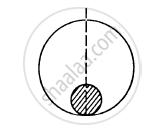Advertisements
Advertisements
प्रश्न
Multiple Choice Question. Select the correct option.
The mass of earth is 6 × 1024 kg and radius of earth is 6.4 × 106 m. The magnitude of force between the mass of 1 kg and the earth is:
विकल्प
9.770 N
9.810 N
830 N
9.790 N
उत्तर
9.770 N
Explanation:
Mass of earth = m1 = 6 × 1024 kg
Mass of the body = m2 = 1 kg
Radius of earth = r = 6.4 × 106 m
Universal gravitational constant = G = 6.67 × 10−11 Nm2 kg−2
Force = F = ?
F = `("G m"_1 "m"_2)/"r"^2=(6.67xx10^-11xx6xx10^24xx1)/(6.4xx10^6)^2`
= `(6.67xx6xx10^(-11-12+24))/(6.4xx6.4)`
F = `(6.67xx6xx10)/(6.4xx6.4)`
F = 9.770 N
APPEARS IN
संबंधित प्रश्न
How does the force of gravitation between two objects change when the distance between them is reduced to half?
Calculate the force of gravitation between the earth and the Sun, given that the mass of the earth = 6 × 1024 kg and of the Sun = 2 × 1030 kg. The average distance between the two is 1.5 × 1011 m.
Can we apply Newton’s third law to the gravitational force ? Explain your answer.
Let V and E be the gravitational potential and gravitational field at a distance r from the centre of a uniform spherical shell. Consider the following two statements :
(A) The plot of V against r is discontinuous.
(B) The plot of E against r is discontinuous.
Inside a uniform spherical shell
(a) the gravitational potential is zero
(b) the gravitational field is zero
(c) the gravitational potential is same everywhere
(d) the gravitational field is same everywhere
A solid sphere of mass m and radius r is placed inside a hollow thin spherical shell of mass M and radius R as shown in the following figure . A particle of mass m' is placed on the line joining the two centres at a distance x from the point of contact of the sphere and the shell. Find the magnitude of the resultant gravitational force on this particle due to the sphere and the shell if (a) r < x < 2r, (b) 2r < x < 2R and (c) x > 2R.

The mass of moon is about 0.012 times that of earth and its diameter is about 0.25 times that of earth. The value of G on the moon will be:
How will the force of gravitation between two objects change if the distance between them is:
Halved
Law of gravitation gives the gravitational force between
Three uniform spheres, each having mass m and radius r, are kept in such a way that each touches the other two. The magnitude of the gravitational force on any sphere due to the other two is
